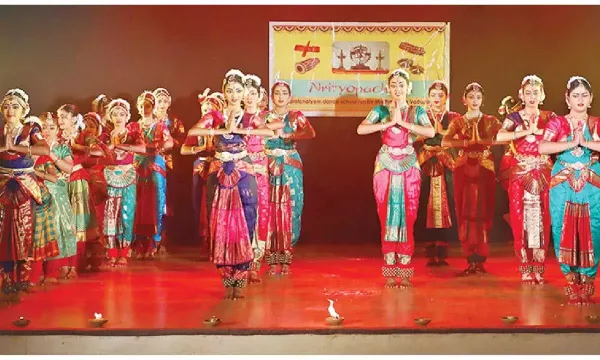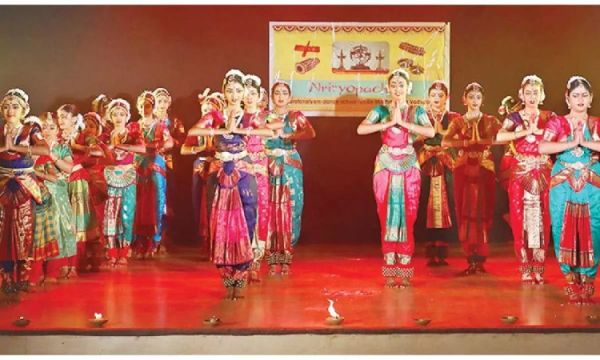
The inaugural ballet of the Nrityopachara Bharatanatyam dance school, founded by Praveena Vadapalli in 2015, is set to be presented on October 6, 2024, at Bharatiya Vidya Bhavan in Basheerbagh. The school will present a traditional Bharatanatyam ballet, Sri Ramuni Charitamu, in celebration of nine fruitful years of operation.

Praveena, who has a group of twenty energetic and passionate young performers, has selected mostly classical pieces for her ballet, with a few new pieces composed especially for it by Sri Dandibotla Vaikunta Narayana Murthy and put to music by Pavani Mutnuri.
Two key scenes of the ballet, “Sita Apaharana” and “Surpanakha,” are scheduled to be particularly noteworthy. Renuka Prasad choreographed the jatis for the “Sita Apaharana” scene, while Vidwan Sri D V Prasanna Kumar, Praveena’s Nattuvangam Guru, wrote the jatis for the “Yuddham” episode.
Renowned musicians from the twin cities, including Sri Kanakam Chandra Rao on vocals, Chandrakanth on mridangam, Sai Kolanka on violin, Uma Venkateswarulu on flute, and Sridhar Acharya on rhythms, make up the musical group that will complement the event. CTSS scholarship recipients Ananya Krishna Kumar (Surpanakha), Shreya Kalluri (Hanuman), and Nandini Sripathi (Rama) will play key parts. Amulya Kriti Boddapati as Ravana, Shubhi Gupta as Lakshmana, and Annika Athmakuri as Sita are among the other performers.
To create the tone for the performance, Sri Ramuni Charitamu will start with a traditional Pushpanjali and end with Adi Shankaracharya’s Eka Sloki Ramayanam. The Putrakamesti Yagam will be represented with a composition by Sri Dandibotla Narayana Murthy titled “Sita Ramula Siri Charitammu.” “Sri Rama Chandra Nanu Brova Manchi Samayamu Ra,” a Varnam in Todi that covers stories like Viswamitra Yagam and Tataki’s defeat before Sita Swayamvaram, will be performed in the ballet.
Praveena deftly introduced Sita, who was playing ball with her companions while covered up by a veil, using a Mallari. The scene changes to the upbeat, humorous Tamil song “Swayamvaran Vela Vandadu” (hasya rasa). After the kings’ fruitless attempts to raise the bow, Ravana also fails. It is expected that “Sita Kalyana Vaibhava” would create a joyful ambiance in the auditorium.
Two gifted dancers from Nishrinkhala, Sravani and Shravya, will perform a traditional song from the Luva Kusa movie called “Ramanna Ramudu” to illustrate Rama’s Pattabhishekam. The proclamation of the celestial coronation will be made during this joyous event.
She may be seen pleading for the blessings to drive out Rama and Lakshmana in the Kaikeyi episode of Todi Varnam. For Guha’s welcome to Rama and Ganges crossing, the Ramadasa Keertana, or “Ramayya Tandri,” will be performed in a traditional manner. The Surpanakha episode, a crucial sequence, was composed especially for this ballet. Praveena took inspiration from Tulsidas Ramayana to emphasize Surpanakha’s relationships with Rama and Lakshmana, which culminated in her change and assault on Sita, which resulted in the amputation of her nose and ears. Ananya will play Surpanakha.
Full of dynamic jatis, the “Sita Apaharana” section is a much-awaited event. These include the scene with Sita and Rama in the jungle, the sight of the golden deer, the pursuit, and the arrival of Ravana, which ends with Jatayu and Ravana fighting.
The Purandara Dasa Keertana, “Hanumanta Deva Namo,” will serve as the visual representation of the Sundarakanda portion, which will conclude with Lankadahanam. An Annamacharya Keertana, “Bhali Bhali Rama,” will be performed with nimble motions to highlight the work of the monkey army in the construction of the Rama Setu. The battle scenarios will be accompanied by “Sara Sara Samari,” which will have alternating jatis to increase the tension.
The ballet will come to an end with the iconic piece “Kalyana Rama,” including Rama’s Pattabhishekam as he enters the theater via the crowd. The coronation events will be portrayed in an anonymous work, “Sri Rama Pattabhishekam,” which has been tuned by Kanakam Chandar Rao. The concert will conclude with a Mangalam, “Ramachandrayya Mangalam.”